Stone Age Peoples - Katalog Lampen - Photo gallery
Image database with photographs of ancient art and antiquities
Our image database provides photographs of ancient art and antiquities for press releases as well as for private use. All artefacts sold in our gallery are documented through professional photographs. The resulting image library contains numerous ancient Egyptian, Greek and Roman antiquities as well as ancient coins. The time span from Stone Age, over Bronze Age and Classical Antiquity until Late Antiquity is covered.The photo gallery aims at providing a vast visual archive equipped with filters and search tools. You are most welcome to search the constantly growing number of artefacts in the image library. We are also happy to authorize hyperlinks from your webpage / forum to the objects depicted in our gallery. For this purpose, please send us a short notification prior to placing a hyperlink. For almost every object high definition photographs are available and can be provided e.g. to document your collection or for scientific papers or popular science articles. If you are interested in using pictures for publications, print media or other purposes, please contact us and we will be happy to assist you.
-
 Messer, Homo Neanderthalensis
Messer, Homo NeanderthalensisMesser, mittleres Paläolithikum. Bearbeitung durch Neandertaler, 60000 v. Chr. bis 40000 v. Chr.
Price: on request Schaber, Homo Neanderthalensis
Schaber, Homo NeanderthalensisSchaber, mittleres Paläolithikum. Bearbeitung durch Neandertaler, 60000 v. Chr. bis 40000 v. Chr.
Price: on request Dick-Nacken-Hohl-Beil
Dick-Nacken-Hohl-BeilNeolithisches Beil aus Feuerstein. Dechsel Typ Horneby. 118mm lang. Fundort: Boltinge, Fünen, Dänemark.
Price: on request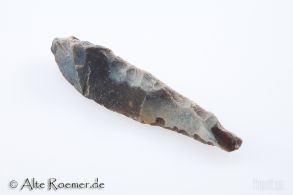 Bohrer aus dem Mesolithikum
Bohrer aus dem MesolithikumBohrer aus Feuerstein, Kongemose Kultur. Fundort Hindsholm, Fünen, Dänemark.
Price: on request Mesolithische Axt
Mesolithische AxtErtebølle-Ellerbek-Kultur. 85mm lang, Salzwasserpatina. Fundort Fyns Hoved, Dänemark. Etwa 5000 v. Chr.
Price: on request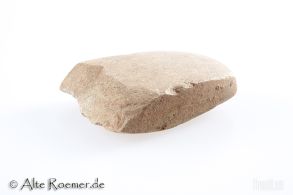 Kleiner Axtkopf
Kleiner AxtkopfNeolithisches kleines Beil. Sehr schöne polierte Oberfläche und feine Bearbeitung. 42mm x 33mm x 12mm. Fundort: Osteuropa.
Price: on request Beil / Hammer, Trichterbecherkultur
Beil / Hammer, TrichterbecherkulturUrsprüngliches Beil, das als Schlagstein wiederverwendet wurde. Neolithikum, 4200 bis 2800 v.Chr. Interessantes Zeugnis für den Wert von Feuerstein als Rohstoff. 100mm x 40mm x 40mm.
Price: on request Hand axe from Galilee
Hand axe from GalileeBig paleolithic hand axe. The universal stone age tool could be use as a borer or cutting tool. Around 500,000 to 200,000 BC.
Price: on request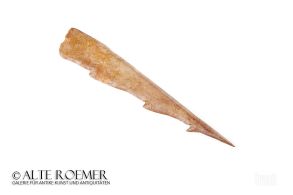 Harpoon of the Maglemosian culture
Harpoon of the Maglemosian cultureFine craftsmanship hunting weapon. Important evidence of the beginnings of fishing in Northern Europe. Mesolithic, 9000 to 6500 BC.
Price: on request Neolithic flint sickle
Neolithic flint sickleHalfmoon shaped blade with fine edges. Nice and typical example for this neolithic type of tool.
Price: on request Neolithic chisel of green stone
Neolithic chisel of green stoneThe stone age tool of the younger Funnel beaker culture or Single Grave culture is exceptional because if its material. It is made of beautiful finely polished green stone.
Price: on request Polished stone age axe head
Polished stone age axe headThe small tool from the younger Stone Age has a nicely polished surface revealing the beautiful black stone it is made of. Approx. 4200 to 2400 BC.
Price: on request Small battle axe of the Single Grave culture
Small battle axe of the Single Grave cultureThe axe head from the younger Stone Age has a compact shape. Axes that have clearly been used as weapons are rare. Most axe types have probably served peaceful purposes.
Price: on request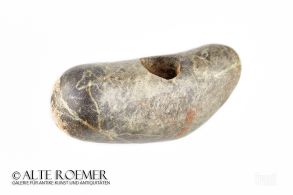 Finely polished hammer axe
Finely polished hammer axeThe compact axe head is made of beautiful and polished green-black stone with white veins. Late Neolithic to Copper Age.
Price: on request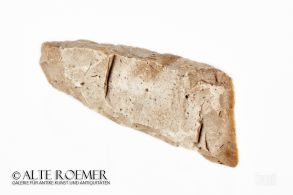 Axe head from neolithic Northern Europe
Axe head from neolithic Northern EuropeThe object is a trapezoid thick-butted thin bladed axe head dating to the Passage Grave Period to Dagger Period. 3200 to 1950 BC.
Price: on request Paleolithic hand axe
Paleolithic hand axeThe universal tool of the older Stone age. It could be used as a borer or a cutter. Approx. 500,000 to 200,000 BC.
Price: on request Neolithic dagger
Neolithic daggerNicely worked flint dagger of type III. Sprove on the Danish Island of Moen was the find spot. 1700 to 1500 BC.
Price: on request Scandinavian flint dagger
Scandinavian flint daggerNicely worked flint dagger from the transitional period between Late Neolithic and Early Bronze Age. Jungshoved on the Danish Island of Moen was the find spot.
Price: on request Vessel of the Linear Pottery culture
Vessel of the Linear Pottery cultureThe beautifully decorated tableware or cookware was made by the earliest peasants of Central Europe, the Neolithic Linear Band Ware settlers. A find from Southern Germany in great condition.
Price: on request Vessel of the Linear Pottery culture in Mintraching
Vessel of the Linear Pottery culture in MintrachingThe beautifully decorated tableware or cookware was made by the earliest peasants of Central Europe, the Neolithic Linear Band Ware settlers. A find from Mintraching in Southern Germany.
Price: on request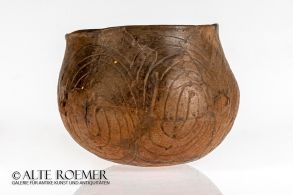 Vessel of the Linear Pottery culture
Vessel of the Linear Pottery cultureThe beautifully decorated tableware or cookware was made by the earliest peasants of Central Europe, the Neolithic Linear Band Ware settlers. A find from Southern Germany in great condition.
Price: on request Vessel of the Linear Pottery culture
Vessel of the Linear Pottery cultureThe beautifully decorated tableware or cookware was made by the earliest peasants of Central Europe, the Late Stone Age Linear Band Ware settlers. A find from Southern Germany in great condition.
Price: on request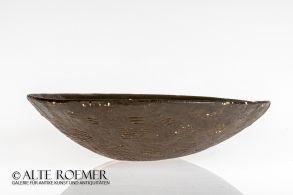 Bowl of the Linear Pottery culture
Bowl of the Linear Pottery cultureLarge flat bowl or deep plate from the earliest peasants of Central Europe, the Neolithic Linear Band Ware settlers. A well preserved piece found in Riekofen in Southern Germany.
Price: on request Large storage vessel of the Linear Pottery culture
Large storage vessel of the Linear Pottery cultureThe imposing vessel was made by the earliest peasants of Central Europe, the Neolithic Linear Band Ware settlers. A find from Southern Germany in great condition.
Price: on request Neolithic axe head from Luetzow in Northern Germany
Neolithic axe head from Luetzow in Northern GermanyNice polished axe from brown flint. It was found more than 100 years ago near the town of Luetzow.
Price: on request Neolithic sickle from Northern Germany
Neolithic sickle from Northern GermanySmall crescent-shaped blade made of beautiful grey flint. This tool represents an intermediate state within the radical transition from Neolithic to Bronze Age.
Price: on request Neolithic sickle from Northern Germany
Neolithic sickle from Northern GermanyCrescent-shaped blade made of beautiful grey flint. This tool represents an intermediate state within the radical transition from Neolithic to Bronze Age.
Price: on request Neolithic chisel from Northern Germany
Neolithic chisel from Northern GermanyElegantly shaped chisel with two polished sides. Made of grey flint. Approx. 3400 to 2400 BC.
Price: on request Dagger blade made of beautiful flint
Dagger blade made of beautiful flintThe finely worked long blade was found in Luetzow in Northern Germany. The artefact was made towards the end of the Neolithic.
Price: on request Neolithic axe head from Luetzow in Northern Germany
Neolithic axe head from Luetzow in Northern GermanyPolished axe made of beautiful brown flint. It was found more than 100 years ago near the town of Luetzow.
Price: on request Neolithic chisel from Northern Germany
Neolithic chisel from Northern GermanyElegantly shaped chisel with two polished sides. Made of dark flint. Approx. 3400 to 2400 BC.
Price: on request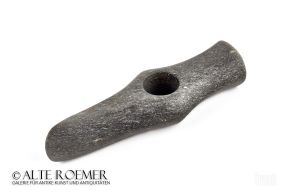 Hammer axe of the Single Grave culture
Hammer axe of the Single Grave cultureGorgeous axe head made of polished dark rock. Made by the Single Grave culture and found in northern Germany.
Price: on request Small axe head from the New Stone Age
Small axe head from the New Stone AgeCompact stone axe from the 3rd Millenium BC. Found on the Danish island of Moen.
Price: on request Paleolithic hand axe of Homo Erectus
Paleolithic hand axe of Homo ErectusBig hand axe from Niger. Made during the Old Stone Age, around 200,000 years ago. The universal stone age tool could be use as a borer or cutting tool.
Price: on request Neolithic sickle from Northern Germany
Neolithic sickle from Northern GermanySmall crescent-shaped blade made of beautiful polychrome flint. This tool represents an intermediate state within the radical transition from Neolithic to Bronze Age.
Price: on request Small Neolithic sickle from Northern Germany
Small Neolithic sickle from Northern GermanyThe crescent-shaped blade is made of reddish brown flint. This tool represents an intermediate state within the radical transition from Neolithic to Bronze Age.
Price: on request

